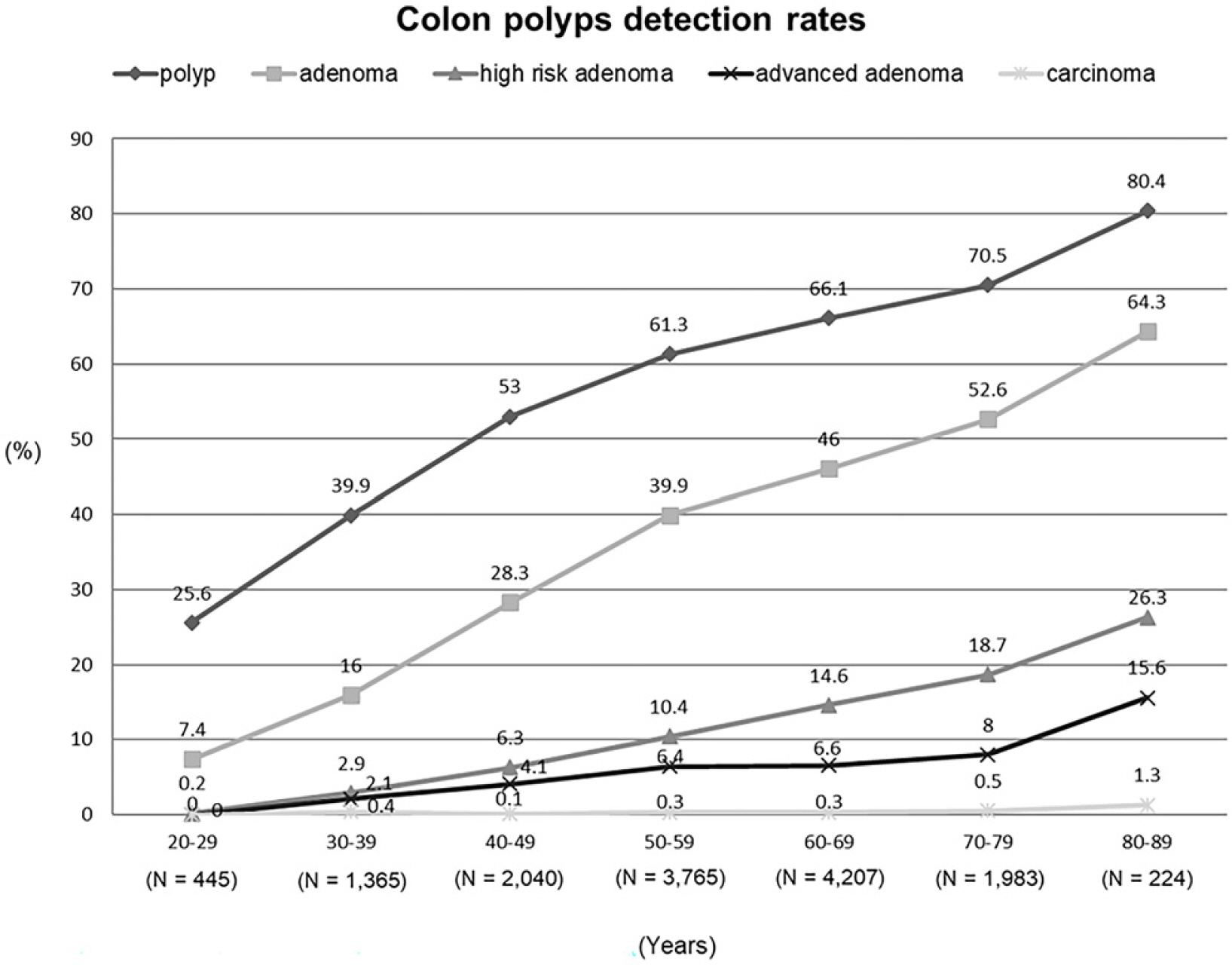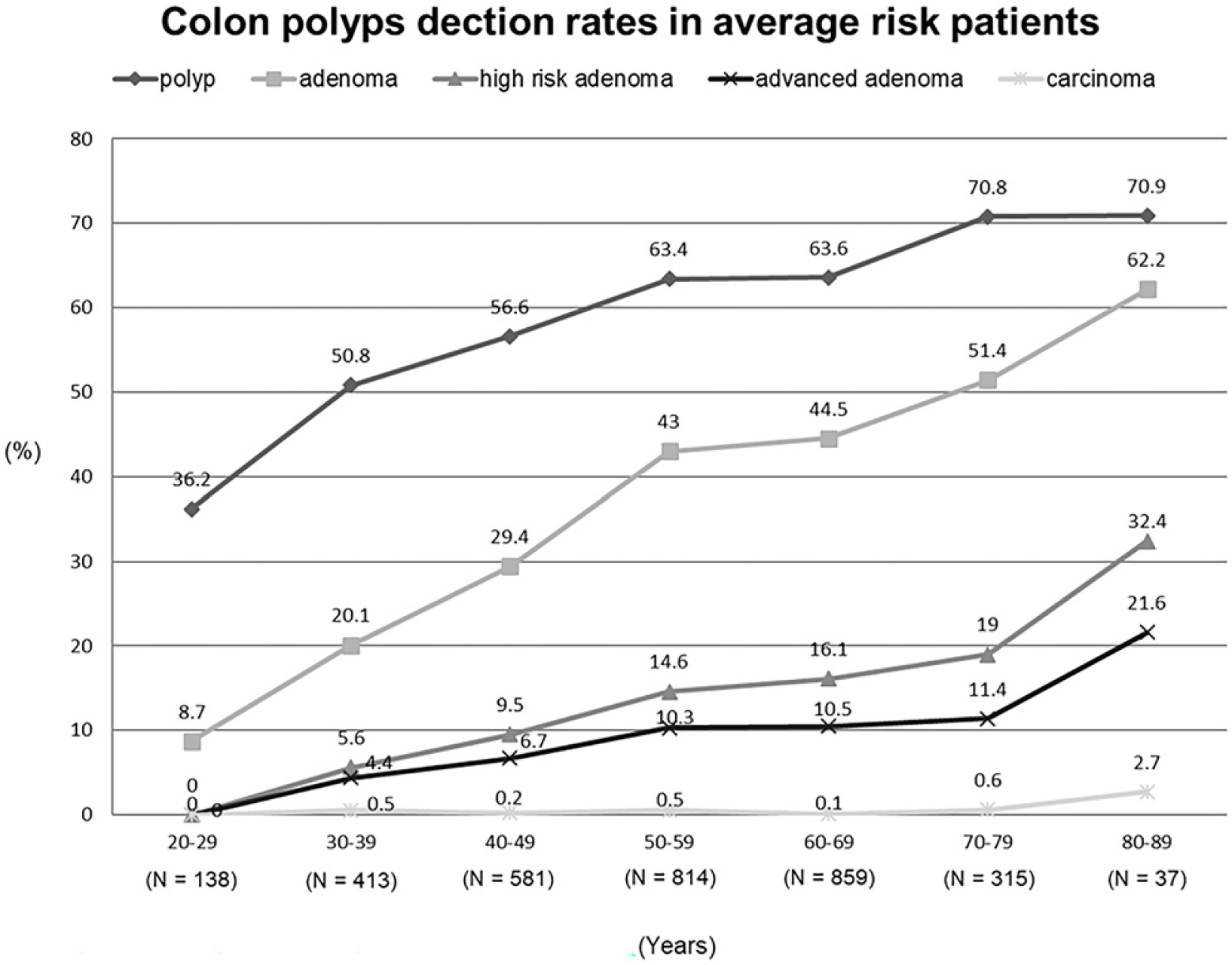Korean J Gastroenterol.
2021 Dec;78(6):328-336. 10.4166/kjg.2021.123.
Colon Polyp Detection in Primary Health Care Institutions of Korea: Detection Rate and Issues with Following the Guidelines
- Affiliations
-
- 1Seoul SOK Clinic, Seoul, Korea.
- 2Hiqhong IM Clinic, Incheon, Korea.
- 3Incheon SOK Clinic, Incheon, Korea.
- 4Jangbaro Clinic, Uijeongbu, Korea.
- 5Sundu United Medical Clinic, Icheon, Korea.
- 6Samsungtop Internal Medicine, Bucheon, Korea
- 7Department of Internal Medicine, Seoul Bon Clinic, Seoul, Korea.
- 8Dr. Kim Young Kwan's office, Seoul, Korea.
- 9Yonsei Choisun Internal Medicine Clinic, Incheon, Korea.
- 10Hunhunhan Internal Medicine Clinic, Seoul, Korea.
- 11Lim's Internal Medicine Clinic, Gapyeong, Korea.
- 12Seoul Medical Clinic, Seoul, Korea.
- KMID: 2523594
- DOI: http://doi.org/10.4166/kjg.2021.123
Abstract
- Background/Aims
There have been few multicenter studies on colonic polyps conducted by primary medical institutions. This study examined the detection rate of colonic polyps in primary health care institutions and the related factors while following the guidelines.
Methods
The medical records of 14,029 patients who underwent colonoscopy between January-June 2020 at 40 primary medical institutions in Korea were analyzed. High-risk adenoma was defined as advanced adenoma, carcinoma, or ≥3 adenomas.
Results
Most patients (71.2%) aged ≥50 years underwent re-colonoscopy within 5 years (51.3%) for diagnostic purposes (61.3%) in Korean primary medical institutions. The detection rates of colon polyps, adenoma, advanced adenoma, high-risk adenoma, and carcinoma was 59.9%, 38.9%, 5.9%, 11.4%, and 0.3% in all subjects and 59.8%, 37.5%, 8.5%, 12.9%, and 0.3% in average-risk patients, respectively. The incidences of adenoma in average-risk patients increased significantly with age (30s/40s/50s: 20.1%/29.4%/43% for adenoma, 4.4%/6.7%/10.3% for advanced adenoma, and 5.6%/9.5%/14.6% for high-risk adenoma; p<0.05). Before 50 years of age, high-risk adenoma was detected in 9.1% of patients in the first-time screening group, and the significant risk factors were being male and ≥40 years of age. The detection rate of high-risk adenoma in the normal index colonoscopy group within 5 years was 9.0%. The significant risk factors included older age, male sex, positive fecal occult blood test, stool form changes, and nonspecific symptoms (gas and indigestion).
Conclusions
More colonic adenoma studies targeting real-world clinical practice will be needed to revise the Korean guidelines for colorectal cancer screening and surveillance.
Keyword
Figure
Reference
-
1. Ferlay J, Soerjomataram I, Dikshit R, et al. 2015; Cancer incidence and mortality worldwide: sources, methods and major patterns in GLOBOCAN 2012. Int J Cancer. 136:E359–E386. DOI: 10.1002/ijc.29210. PMID: 25220842.
Article2. Annual report on the cause of death statistics, 2018. [Internet]. Seoul (KR): Korea National Statistical Office (KNSO);2020. cited 2020 Jan 29. Available from: https://kosis.kr/publication/publicationThema.do.3. Winawer SJ, Zauber AG, Ho MN, et al. 1993; Prevention of colorectal cancer by colonoscopic polypectomy. The National Polyp Study Workgroup. N Engl J Med. 329:1977–1981. DOI: 10.1056/NEJM199312303292701. PMID: 8247072.4. Lee BI, Hong SP, Kim SE, et al. 2012; Korean guidelines for colorectal cancer screening and polyp detection. Clin Endosc. 45:25–43. DOI: 10.5946/ce.2012.45.1.25. PMID: 22741131. PMCID: PMC3363119.
Article5. Yang DH, Hong SN, Kim YH, et al. 2012; Korean guidelines for postpolypectomy colonoscopy surveillance. Clin Endosc. 45:44–61. DOI: 10.5946/ce.2012.45.1.44. PMID: 22741132. PMCID: PMC3363120.
Article6. Cairns SR, Scholefield JH, Steele RJ, et al. 2010; Guidelines for colorectal cancer screening and surveillance in moderate and high risk groups (update from 2002). Gut. 59:666–689. DOI: 10.1136/gut.2009.179804. PMID: 20427401.
Article7. Rex DK, Boland CR, Dominitz JA, et al. 2017; Colorectal cancer screening: recommendations for physicians and patients from the U.S. Multi-Society Task Force on Colorectal Cancer. Gastrointest Endosc. 86:18–33. DOI: 10.1016/j.gie.2017.04.003. PMID: 28600070.
Article8. Gupta S, Lieberman D, Anderson JC, et al. 2020; Recommendations for follow-up after colonoscopy and polypectomy: a consensus update by the US Multi-Society Task Force on Colorectal Cancer. Gastroenterology. 158:1131–1153.e5. DOI: 10.1053/j.gastro.2019.10.026. PMID: 32044092. PMCID: PMC7672705.
Article9. Djinbachian R, Dubé AJ, Durand M, et al. 2019; Adherence to post-polypectomy surveillance guidelines: a systematic review and meta-analysis. Endoscopy. 51:673–683. DOI: 10.1055/a-0865-2082. PMID: 30909308.
Article10. Hong S, Suh M, Choi KS, et al. 2018; Guideline adherence to colonoscopic surveillance intervals after polypectomy in Korea: results from a nationwide survey. Gut Liver. 12:426–432. DOI: 10.5009/gnl17403. PMID: 29429156. PMCID: PMC6027840.
Article11. Park DI, Kim YH, Kim HS, et al. 2006; Diagnostic yield of advanced colorectal neoplasia at colonoscopy, according to indications: an investigation from the Korean Association for the Study of Intestinal Diseases (KASID). Endoscopy. 38:449–455. DOI: 10.1055/s-2006-925227. PMID: 16767578.
Article12. Park HW, Byeon JS, Yang SK, et al. 2009; Colorectal neoplasm in asymptomatic average-risk Koreans: The KASID prospective multicenter colonoscopy survey. Gut Liver. 3:35–40. DOI: 10.5009/gnl.2009.3.1.35. PMID: 20479899. PMCID: PMC2871563.
Article13. Chung SJ, Kim YS, Yang SY, et al. 2010; Prevalence and risk of colorectal adenoma in asymptomatic Koreans aged 40-49 years undergoing screening colonoscopy. J Gastroenterol Hepatol. 25:519–525. DOI: 10.1111/j.1440-1746.2009.06147.x. PMID: 20370730.14. Lieberman D. 2010; Progress and challenges in colorectal cancer screening and surveillance. Gastroenterology. 138:2115–2126. DOI: 10.1053/j.gastro.2010.02.006. PMID: 20167216.
Article15. Regula J, Rupinski M, Kraszewska E, et al. 2006; Colonoscopy in colorectal-cancer screening for detection of advanced neoplasia. N Engl J Med. 355:1863–1872. DOI: 10.1056/NEJMoa054967. PMID: 17079760.
Article16. Imperiale TF, Wagner DR, Lin CY, Larkin GN, Rogge JD, Ransohoff DF. 2002; Results of screening colonoscopy among persons 40 to 49 years of age. N Engl J Med. 346:1781–1785. DOI: 10.1056/NEJM200206063462304. PMID: 12050337.
Article17. Rundle AG, Lebwohl B, Vogel R, Levine S, Neugut AI. 2008; Colonoscopic screening in average-risk individuals ages 40 to 49 vs 50 to 59 years. Gastroenterology. 134:1311–1315. DOI: 10.1053/j.gastro.2008.02.032. PMID: 18471508. PMCID: PMC3673301.
Article18. Chung SJ, Kim YS, Yang SY, et al. 2011; Five-year risk for advanced colorectal neoplasia after initial colonoscopy according to the baseline risk stratification: a prospective study in 2452 asymptomatic Koreans. Gut. 60:1537–1543. DOI: 10.1136/gut.2010.232876. PMID: 21427200.
Article19. Lieberman DA, Weiss DG, Harford WV, et al. 2007; Five-year colon surveillance after screening colonoscopy. Gastroenterology. 133:1077–1085. DOI: 10.1053/j.gastro.2007.07.006. PMID: 17698067.
Article
- Full Text Links
- Actions
-
Cited
- CITED
-
- Close
- Share
- Similar articles
-
- The Colonoscopic Withdrawal Time is Correlated with the Rate of Detecting Polyps When Performing Colonoscopy
- Efficacy of Hood-cap Assisted Colonoscopy; Comparison with Conventional Colonoscopy
- The Correlation between Polyp Detection Rate and Adenoma Detection Rate: Mainly Determined by the Colon Segment
- Efficacy of Second Forward-View Colonoscopy to Improve Adenoma Detection of Right-Side Colon: Systematic Review and Meta-Analysis
- Additional Polyp Detection Rate Using Colonoscopic Retroflexion in Right Colon





